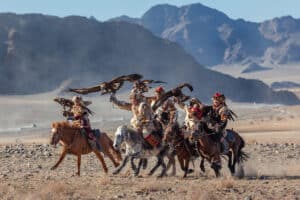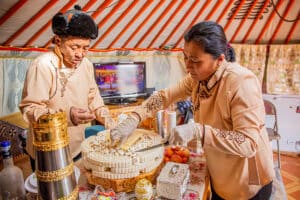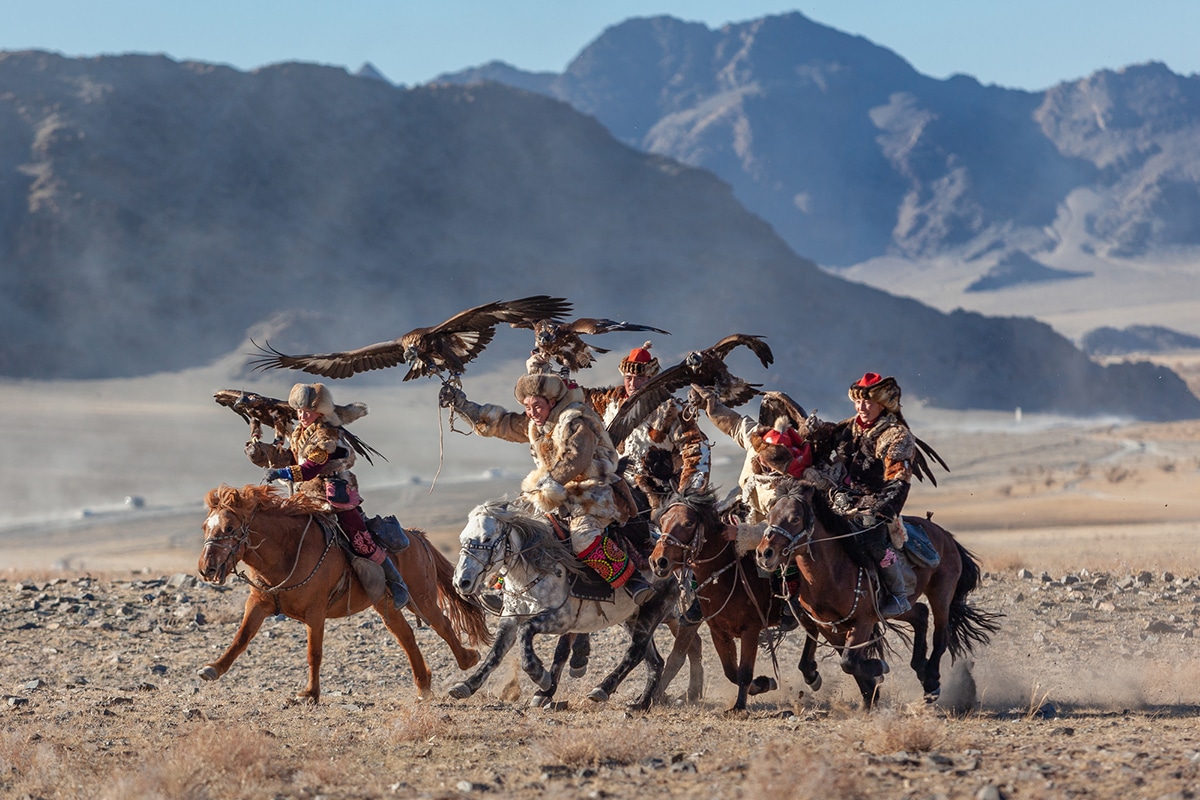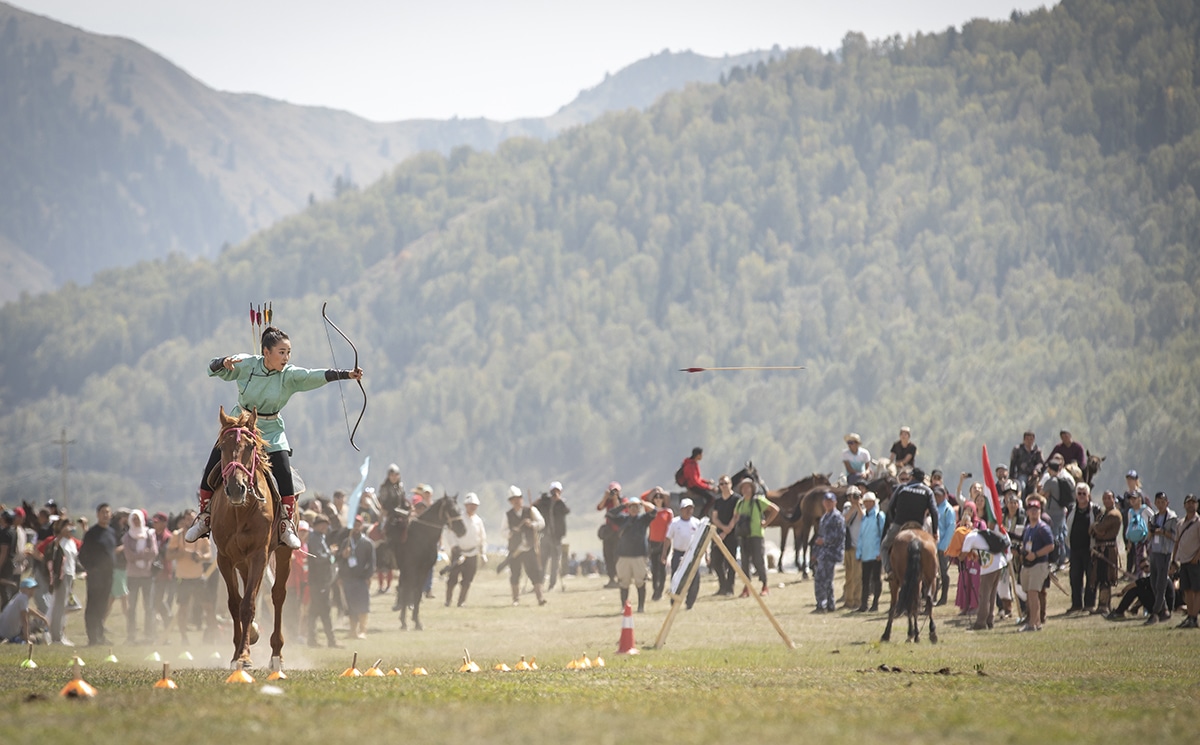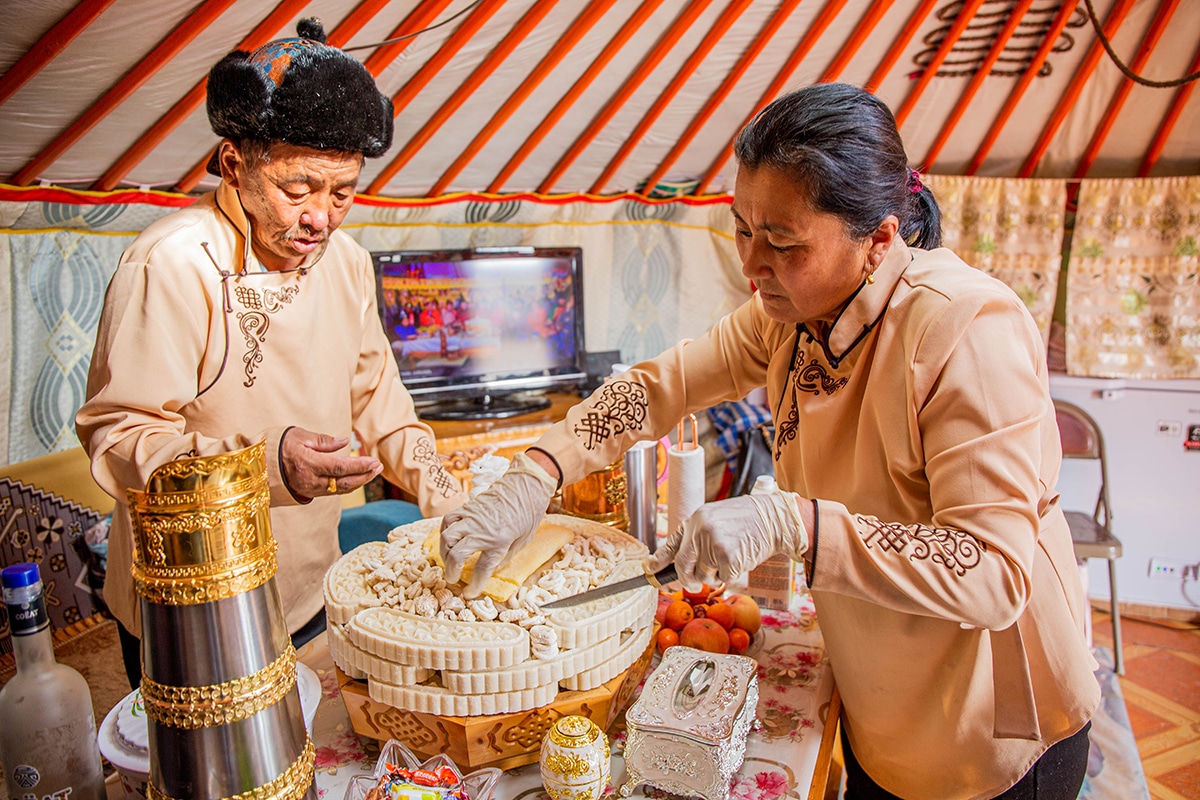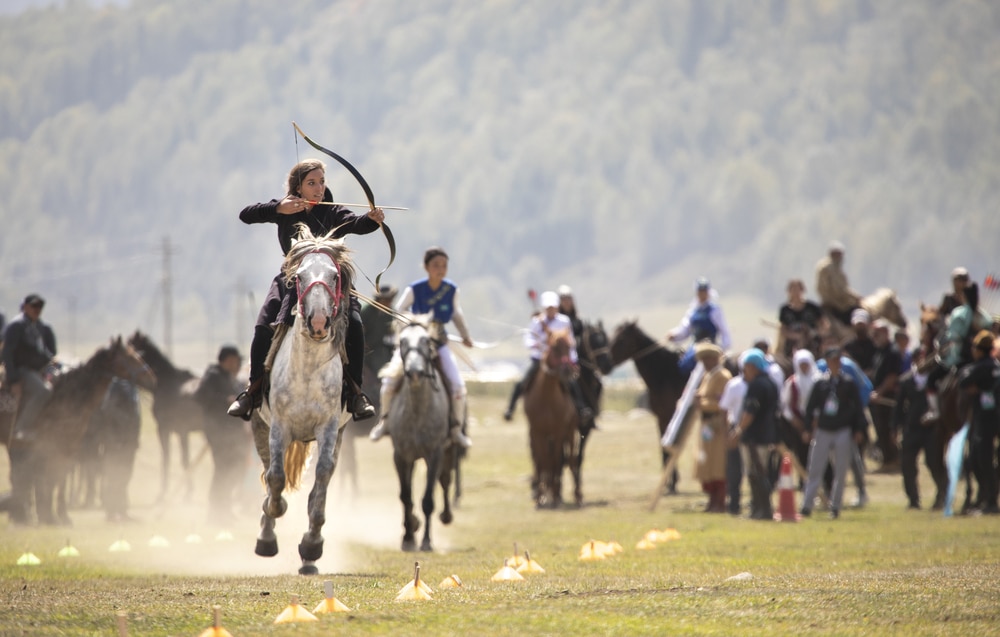The Ultimate Mongolia Food Guide + What to Know if You’re Vegetarian
Looking to learn more about food in Mongolia? Explore some of the national dishes and what you need to know if you’re vegan or vegetarian.
- November 29, 2022
Table of Contents
Food in Mongolia is perfectly described in one word: hearty.
Most Mongolians eat a diet that’s heavy in meat and dairy. That’s because as a culture of nomadic herders, they eat what’s at hand – and that’s whatever their herd supplies. Mongolians have eaten this way for centuries.
Mutton (sheep), goat, and beef are their main source of meat and are often refer to red foods.
Fat, milk, homemade cheese, and creams also play in heavily to the Mongolian food culture. They refer to these as white foods.
In Mongolia, travelers sometimes have a hard time when it comes to Mongolian cuisine. Here, sheep tail fat is a delicacy, dried cheese curds called aaruul are on every table, and salty milk tea is drunk like water, which Mongolians drink very little of. With severe temperatures and long, physical days, this calorie-rich diet has helped them survive harsh conditions and long winters.
Since many of Mongolia’s national dishes consist almost entirely of meat, Mongolians are extremely respectful to the animal husbandry. The methods they use for herding, the attention given to care and protect each and every one of the livestock, and even when it’s time to slaughter animals for the winter, when they’re at their most fat, it’s done humanely.
The animals live long, happy lives grazing their way across the steppe before they meet this fate. Mongolians don’t eat baby animals as it’s not sustainable for their herd. Instead, they prefer to eat the animals that have contributed everything they can to the herd, up until their final days.
Mongolian meat is known to be rich in protein and contain a higher amount of essentials metals, like iron and zinc. Meat here is also known for being particularly strong, chewy, and tough to eat. Meals don’t end there. When an animal is butchered, everything gets consumed – including the heart, intestines, kidneys, eyeballs, brains, head, and tail. Sheep’s head, in particular, is considered a delicacy. When your host shares an eyeball with you, it’s a sign of respect.
Until recently, before it became normal for herding families to have solar-powered freezers inside their gers (yurts), meat was dried as a way of preserving it. Smaller animals are still consumed in the warm months when meat would otherwise spoil too quickly. Larger animals are consumed in the winter months, when holes dug into the ground can act as natural meat refrigerators.
For families that live in the city, it’s during this time (the months leading into winter) that households will purchase a whole cow. This provides enough meat for the family to survive winter when work is slower, food scarcer, and brutally cold days require your body to have a bit more substance to survive.
Below we’ll touch on traditional Mongolian foods, the most popular dishes to eat, and what to know if you plan to visit Mongolia and you have any sort of dietary restriction.
Mongolian Food Traditions
Everything you need to know about how to eat when you’re inside a family home, the most typical Mongolian dishes you’ll be served, and how to not offend your local hosts.
When you’re seated inside a family home (ger) in the Mongolian countryside, it’s perfectly acceptable to eat with your hands. The less dishes you dirty and less mess you create, the less resources and time your hosts have to use to clean up after you.
Soups are often slurped down without a spoon and meat that’s been cooked is often served family style on a tray for everyone to pick and choose from. Meat is always served on the bone and requires some gnawing and chewing on your part. When in doubt, always follow the lead of your host, and always accept whatever piece they hand to you – they’re usually giving you the best bits.
Speaking of soups, soups are a staple food in Mongolia. You can expect a bowl no matter what the temperature is outside, whether it be the middle of summer or the middle of winter. The most common soup is a simple clear broth with noodles, dried meat, and – if you’re lucky – onions, potatoes, and carrots, if the family has some on hand.
Always accept food and drinks with your right hand. This is an important one. Reach out to grab a bowl or plate with your right hand (or two hands, to be careful not to spill) and always make your best effort to eat almost everything on your plate. Cleaning your plate entirely is a signal for your host to serve you more. Which she’ll keep doing until you eventually have to politely decline another serving.
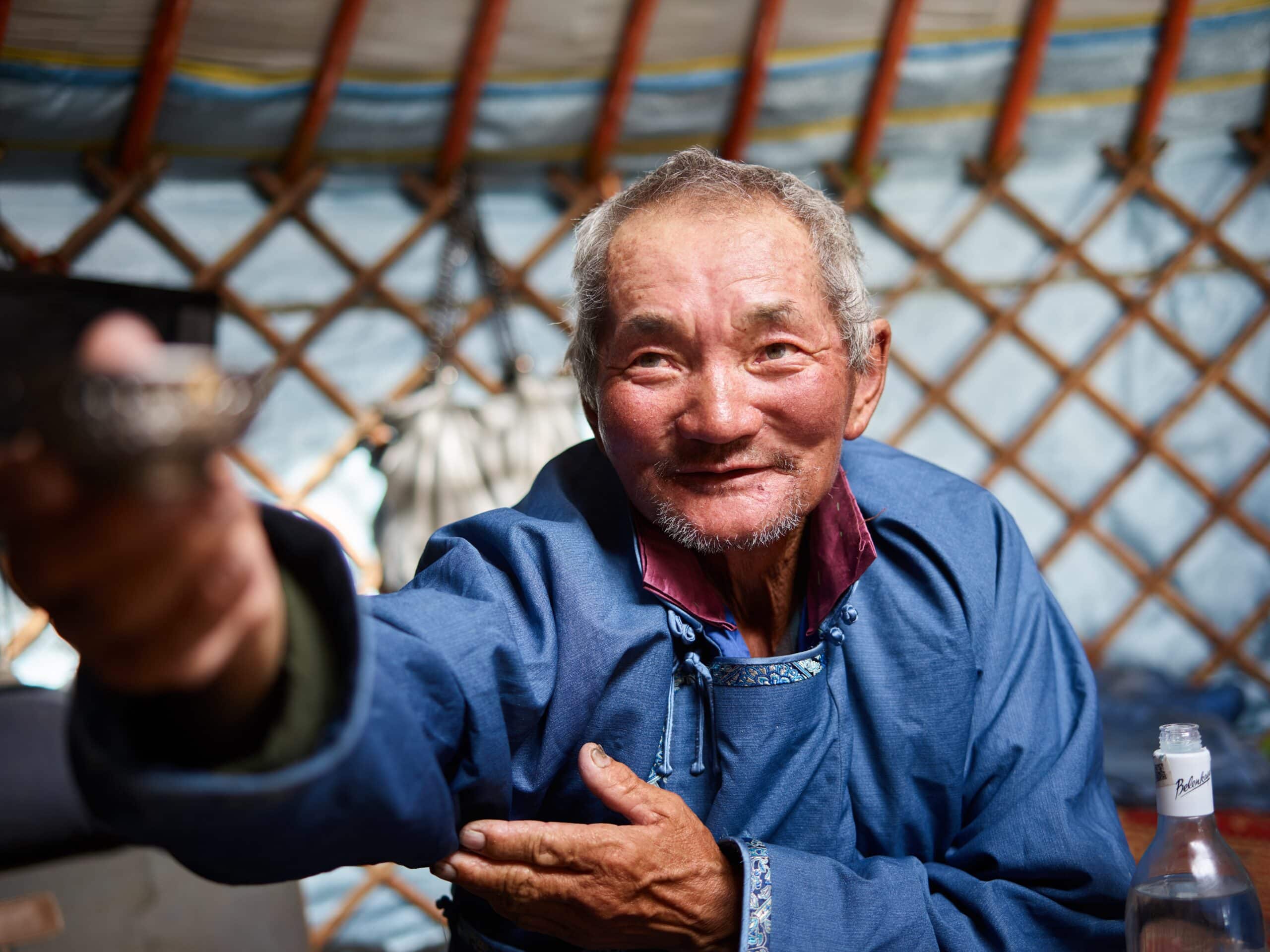
Marmot, while technically illegal to kill and eat, is still widely consumed across the countryside. It’s an easy source of protein that doesn’t take away from a family’s herd. While the bubonic plague is often associated with eating marmot (it’s spread by fleas), it’s considered a delicacy and an honor for a local family to serve it to you. Marmot is often cooked with a blowtorch before being served to guests.
Mongolians rarely eat fish. Fish are considered a sacred animal, so it’s considered taboo to eat them. It was also once believed that powerful spirits lived in the rivers and streams. To keep the balance, taking anything out of these sources of water was frowned upon so that they didn’t make these spirits mad.
You won’t find much poultry or pork here either.
Contrary to what many people believe, Mongolians don’t eat horse meat. Ethnically Kazakh Mongolians in the western part of the country will eat horse sausage, though. In fact, horse jerky is marketed as a pet food. Camel meat is eaten in some places.
Yak butter, yak yoghurt, and yak cheese and milks are some of the bests you’ll find in the country. Camel milk can also be found, but it is not consumed as much as goat or cow milk, which are the most popular. When you’re in the northern part of Mongolia, on the taiga, reindeer milk is the most common type of milk used for cooking and drinking. You can find it in everything from the tea to the bread.
Suutei Tsai, or salty milk tea, is usually the first thing any host offers a guest who enters their ger. It’s drank like water, which you’ll suspiciously start to notice at some point during your trip that most Mongolians don’t drink much of. That’s because milk is more readily available than water, which is a sacred and valuable resource.
The Best Dishes in Mongolian Cuisine
There are a few important things to know about Mongolian cuisine.
First, Mongolians are notorious for not liking salty foods. Even if you’re dining at one of Ulaanbaatar’s best restaurants, you won’t be able to help but notice this. No matter which type of cuisine you’re eating – and you can find them all in Ulaanbaatar – don’t expect any dishes to a-salt your senses. (See what we did there?)
Once you’re in the countryside, and eating with the local nomadic families, this becomes even more apparent. While herding families are moving into the modern world – solar panels and electricity are becoming the norm, gers often have cable TV dishes outside, and others have giant freezers – using salt and spices to food still hasn’t caught on. Herder family eating habits are simple – meals are always made quickly with a priority on the sustenance, and nothing goes to waste. Nothing.
For travelers who aren’t used to this type of diet, there’s one simple trick that will help you survive several days of eating in the countryside, and that’s to always carry hot sauce with you. Always. Otherwise, Mongolian food doesn’t have any spice to it either – there’s nothing that grows here that would add a kick. No chili peppers, no jalapenos in sight.
Speaking of things that don’t grow in Mongolia, don’t expect an array of fruits and vegetables in stores, or across the steppe. These things don’t really grow here either. You can find berries, pine nuts, and other things if you search hard enough, and if you’re traveling in the right season. Just ask the herders to show you what’s around and they’re more than happy to show off their very impressive foraging skills. Wild purple chives, anyone?

That being said, there are certain areas of the country where farming is becoming more common practice. Mongolians are realizing the important of becoming self-sufficient, especially after some particularly difficult months during COVID-19. Today they realize the importance of not wanting to depend on their neighbors (Russia and China) to import all their goods.
In places like Bulgan soum, a small town just 20 minutes from the Flaming Cliffs, some of the country’s best tomatoes are harvested here in the fall. Kharkhorum is another area where agriculture is quickly developing. Closer to Ulaanbaatar, farms such as Ger Garden Organic Farm, the first certified organic farm in Mongolia, is supplying some of the best organic vegetables to shops and restaurants in the city. You can stock up on their leafy greens, tomatoes, and other seasonal fruits and vegetables at The Market by Rosewood and E-mart.
Now that we’ve gotten those Mongolian food details out of the way, let’s touch on some of the foods in Mongolia that are considered their national dishes.
The 6 Best Mongolian Foods
Buzz
Often considered Mongolia’s national dish, buuz are Tibetan-style dumplings typically filled with goat or sheep (mutton). Some families add onion, garlic, or foraged greens, if available. Buuz are steamed for about 20 minutes before being served. For holidays like Tsagaan Sar (Mongolian Lunar New Year), families will make hundreds, if not thousands, of buuz for family and friends to feast on through the holiday celebrations.
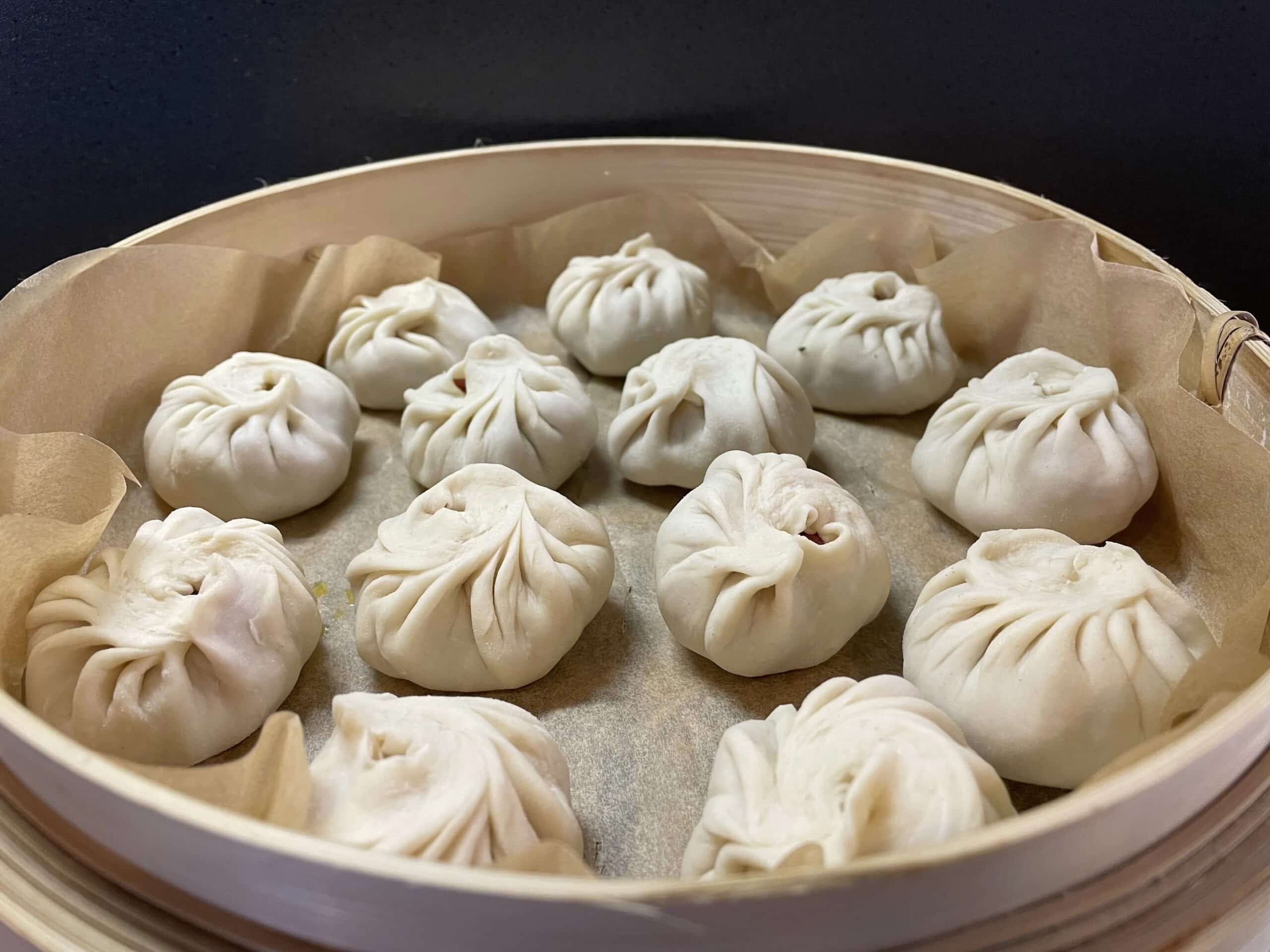
Khorkhog
Khorkhog is often called Mongolian barbecue. It’s made by cooking pieces of meat in a container with hot stones layered between the meat and then placed over a fire. The bones are left on the meat and potatoes and carrots are added to the top of the container before water is added and it’s sealed tightly creating a vacuum that pressure cooks the meat. No spices or salt are added. After cooked over the fire for about an hour and a half, the container is opened, and the contents are poured onto a cooking sheet. Everyone eats with their hands, typically squatting around the sheet as each person reaches for the cuts of meat they like most.

Tsuivan
It’s hard not to love Tsuivan. A simple fried noodle dish that’s found everywhere, tsuivan never disappoints and helps break up some of the meat-heavy, greasy meals you’ll have for days on end. Handmade noodles made from flour and water, dried meat (called borts), some sheep tail fat for added flavor, and carrots and potatoes for good measure, are all stir-fried together to create this crowd-pleasing Mongolian dish. Like we said, what’s not to love?

Khuushuur
Khuushuur is the equivalent to a Mongolian hot pocket and is a real street food in Mongolia food culture. Khuushuur travels well, it’s easy to make, and it’s often found at roadside stands in every region of the country. Beyond that, it’s a staple food at national festivals such as Naadam. Khuushuur is typically made from mutton that’s been minced with onion and garlic then wrapped in dough that’s rested for at least 15 minutes. The dough is flattened into small circular shapes before scooping the meat into it and folding the edges to make a half-moon shape. They are then fried, usually in a large wok, over a fire until they turn golden-brown in color before being served.

Aaruul
Dried curds, or aaruul, are another staple food in Mongolia. They are often served with tea as soon as a guest enters the ger. The first thing most people notice when they try aaruul for the first time is how strong it is in taste. That’s because they’re made from curdled milk. The curdled milk is then boiled in order to thicken it, placed in a fine cloth bag, and weighed down with stones to remove the liquids. Then, it’s left in the sun to dry and eventually broken or cut into pieces and placed on the center of a table in an ornate bowl. Nomadic people sometimes carry these curds with them as a snack thanks to being full of essential vitamins. Be warry of your teeth when trying aaruul for the first time, it can be as hard as the stones it was left to dry out under.

Airag
Fermented mare’s milk is one of the best Mongolian drinks to try when you visit. Salty and carbonated, airag is typically made in July and August when the mares have an abundance of milk as their spring foals grow bigger and older. It’s around this time when Naadam, the country’s biggest and most important national festival takes place and airag is synonymous with those celebrations. Airag is made in an open leather sack, called a khukhuur, that’s hung inside the ger and left to ferment. Its milky white color gives it away and you can often find it being sold on the side of the road in recycled bottles, especially during these two months.

I’m a vegetarian/vegan traveling to Mongolia, what can I eat?
If you’re a vegetarian or vegan traveling to Mongolia, there are a few things you need to know before your trip.
First, always ask the tour guide or tour company you’re traveling with if and how they can accommodate for your diet. If your tour includes a private chef who will be cooking for you during the trip, this isn’t a problem. This also means the tour is probably going to be very expensive.
If your tour steers more toward the ‘authentic’ side, and you’ll be eating with local nomadic families, things are a bit more difficult. No impossible, but certainly more difficult.
Tips for traveling in Mongolia if you are vegetarian, vegan, lactose-intolerant, gluten-free, or have any other dietary restriction:
- Check with your tour guide/tour company on how they can accommodate your eating habits and dietary restrictions during your trip.
- Pack snacks. Lots of snacks.
- Understand that politely declining a meal doesn’t make you rude. Your translator can explain this to the host who will continue to offer you food out of respect. At any time feel free to quietly and politely excuse yourself if you don’t want to take part in any of the butchering or cooking process.
- More snacks. Always more snacks.
- Before leaving Ulaanbaatar, stock up on vegan or vegetarian food options at places like Good Price, E-mart, or the State Department Store. It’s becoming more common to find veggie burgers, vegetable buuz, gluten-free snacks, and more inside the city center.
When you’re in Ulaanbaatar, there are plenty of great vegan and vegetarian restaurants. Some of the most popular vegan and vegetarian restaurants in Ulaanbaatar are: Govinda’s Healthy Vegetarian Café, Agnista Restaurant (near Sukhbaatar Square), Namaste Indian restaurant, Loving Hut, Foody Café inside Shangri-La Mall, and Rosewood Kitchen + Enoteca.

Mongolian Food Culture: Do’s and Don’ts
A few simple do’s and don’ts in Mongolian food culture.
Do:
- Accept food with your right hand or both hands.
- Try everything your host offers you.
- Wash up after yourself if you’re cooking outside, especially near a family’s ger.
- Always offer your hosts what you’re eating or cooking – this is a great chance to bond with them!
Don’t:
- Feel bad for leaving a little bit of food left in your bowl – this means it was delicious but you’re full. Turn up your nose in disgust if your host offers you something you don’t want to try.
- Dump food waste or wash your dishes directly in the river. Water is sacred in Mongolia and food and dirty dish water should be disposed of far away from rivers and streams and away from areas where families graze their herds.
- Feed human food, even apples or carrots, to horses or other animals.
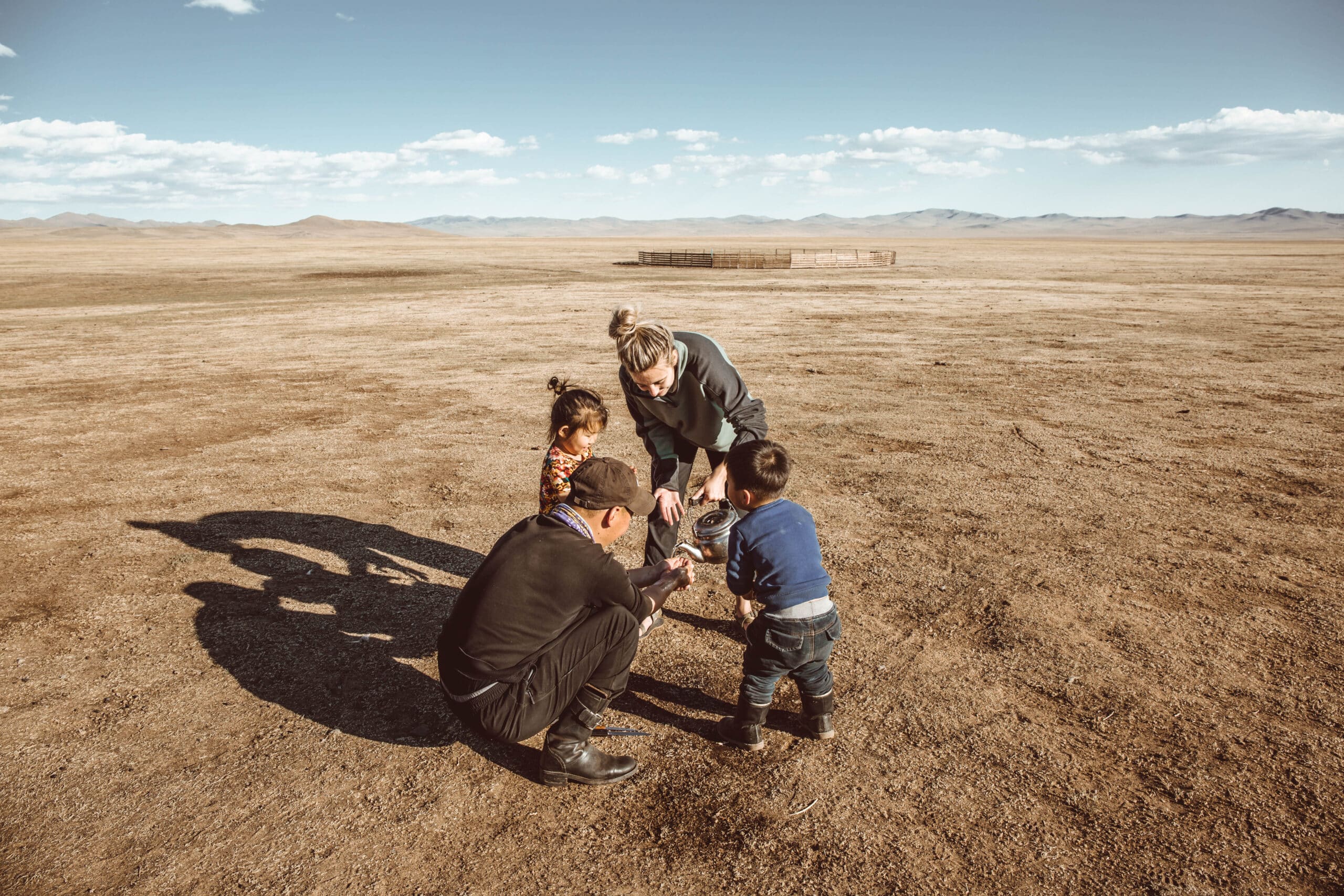
The Most Common Misconceptions About Mongolian Food
There are a few things that most people get wrong about Mongolian food.
First, Mongolian beef is not Mongolian. Like, at all. We hate to break it to you, but Mongolian beef is a dish that was created in Taiwan to sound exotic. There’s nothing Mongolian about Mongolian beef.
Second, Mongolians don’t eat horse. Horses are godly in Mongolian culture and eating them is only done out of pure necessity.
Mongolians have different genes when it comes to drinking, literally. This goes back to the days of Genghis Khan. It’s been proven that Mongolians have a different genetic makeup – one that helps them absorb more alcohol into the bloodstream and break it down at a slower rate than most Europeans. There is some scientific basis to this but let this simply be your warning to watch your alcohol consumption when drinking with locals. Quite frankly, they won’t be able to handle alcohol the way you do.
The Ethical Meat Eaters
Mongolian culture is one of the most resourceful and respectful on the planet. They worship the sun, the land, and the sky, and their predominately Buddhist beliefs carry through to everything they do.
While they do rely on their herds for their daily sustenance, they have the utmost respect for them and Tengger, the god of the sky. They practice ethical husbandry, make use of every single part of the animal when it’s killed, and understand that this way of living is a circle of life. They don’t kill more animals than they need to, and everything is done only out of necessity.
While most vegans and vegetarians don’t eat animals and animal-products for their own reasons, Mongolia is one of the few places where they can understand and respect this different way of living.
Author: Breanna Wilson
Hi! Sain uu! I’m Breanna, an American travel writer and adventurer living in Ulaanbaatar, Mongolia for more than 5 years. I’ve written for and been featured in Condé Nast Traveler, CNN, Forbes, and the New York Times, among others. Read more of my Mongolia travel articles here.
Prepare for your Trip:
Join my Private Travel Group on Facebook
Proudly Based in Ulaanbaatar, Mongolia
© 2024 Meanwhile in Mongolia


